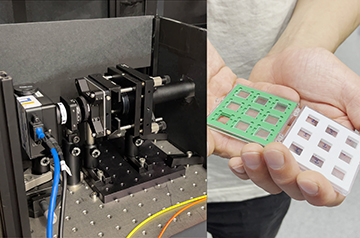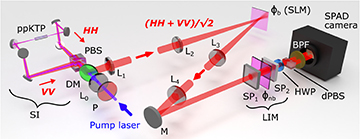
Left: A quantum-enhanced microscope developed and demonstrated by the Q-MIC consortium. Right: A standard protein sample in a silicon substrate was used to calibrate the quantum microscopy platform. [Image: ICFO]
Q-MIC, a European consortium for advancing research in quantum metrology, has demonstrated a quantum-enhanced on-chip interference microscope that improves imaging—without the potentially sample-damaging levels of radiation generated by light sources used in traditional microscopy (Sci. Adv., doi: 10.1126/sciadv.abj2155).
The Q-MIC platform employs pairs of entangled photons as a sort of quantum light to enhance interference patterns during the imaging process. Q-MIC researcher Alvaro Cuevas, ICFO–The Institute of Photonic Sciences, Spain, said in a press release that by harnessing the quantum effect, “we are able to reduce the noise level and increase the sensitivity of the measurements by more than 25% when compared to classical measurements.”
Potential applications of the quantum microscopy technology include biomedical diagnostics, material science, and crystallography.
Enhancing imaging with entangled photons
In traditional microscopy, high light levels are needed to reveal structures in a sample. However, for organic, live, transparent or other sensitive materials, light can literally cook or bleach away important details. Lower illumination levels cause less damage but increase visual background noise, leading to blurry images.
Q-MIC consortium researchers aimed to reduce sample photodamage and increase image clarity by using interference patterns of entangled photons to enhance microscopy images. Compared with photons from a traditional light source, the entangled photons in the Q-MIC setup have shorter wavelengths that improve resolution in phase and speed up the measurement process.
Putting the pieces together
Key components of the Q-MIC platform include a source of space-polarization hyperentangled N00N-state photons, a large field-of-view lens-free interferometric microscope (LIM), and a single photon avalanche diode (SPAD) array camera. (N00N-state photons are photons in a particular many-body entangled state that has proved useful in quantum metrology.)
Setup of the Q-MIC quantum-enhanced microscope. SI, Sagnac interferometer; PBS, polarizing beam splitter; HWP, half-wave plate; L, lenses; P, polarizer; DM, dichroic mirror; M, mirror; ϕb, birefringent sample (SLM); ϕnb, nonbirefringent sample; SP, Savart plate; dPBS, lateral displacement polarizing beam splitter; BPF, band-pass filter. [Image: R. Camphausen et al., Sci. Adv., doi: 10.1126/sciadv.abj2155 (2021); CC BY-NC 4.0] [Enlarge image]
In the setup, the hyperentangled N00N-state photon pairs are created by spontaneous parametric down conversion in a Sagnac interferometer, and are then polarized and divided into vertical and horizontal paths by a Savart plate. The polarized photons next pass through a sample mounted on the LIM. The photon paths change depending on the structure of the sample. A second Savart plate with an opposite orientation to the first plate recombines the two photon paths.
Phase differences in the photon paths caused by sample properties create an interference pattern when passed through a polarizer. The interference pattern is then captured by the SPAD array camera. After this process is repeated several times, a computer algorithm is used to combine the interference patterns to reconstruct a detailed image of the sample.
The researchers used a standard protein sample in a silicon substrate to calibrate the quantum microscopy platform and confirmed that their new device created much smoother, more detailed images with fewer photons than traditional microscopy.
Institutions involved in the EU-funded Q-MIC consortium include project coordinator ICFO, Spain; the Institute of Quantum Optics and Quantum Information, Austria; Politecnico di Milano, Italy; the University of Glasgow, UK; and the Fraunhofer Institute for Applied Optics and Precision Engineering, Germany, with industry partners Carl Zeiss, Germany, and Micro Photon Devices, Italy.

